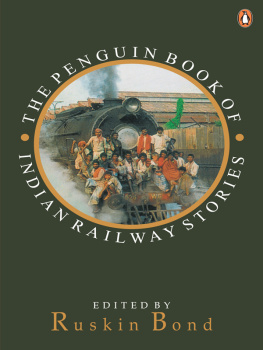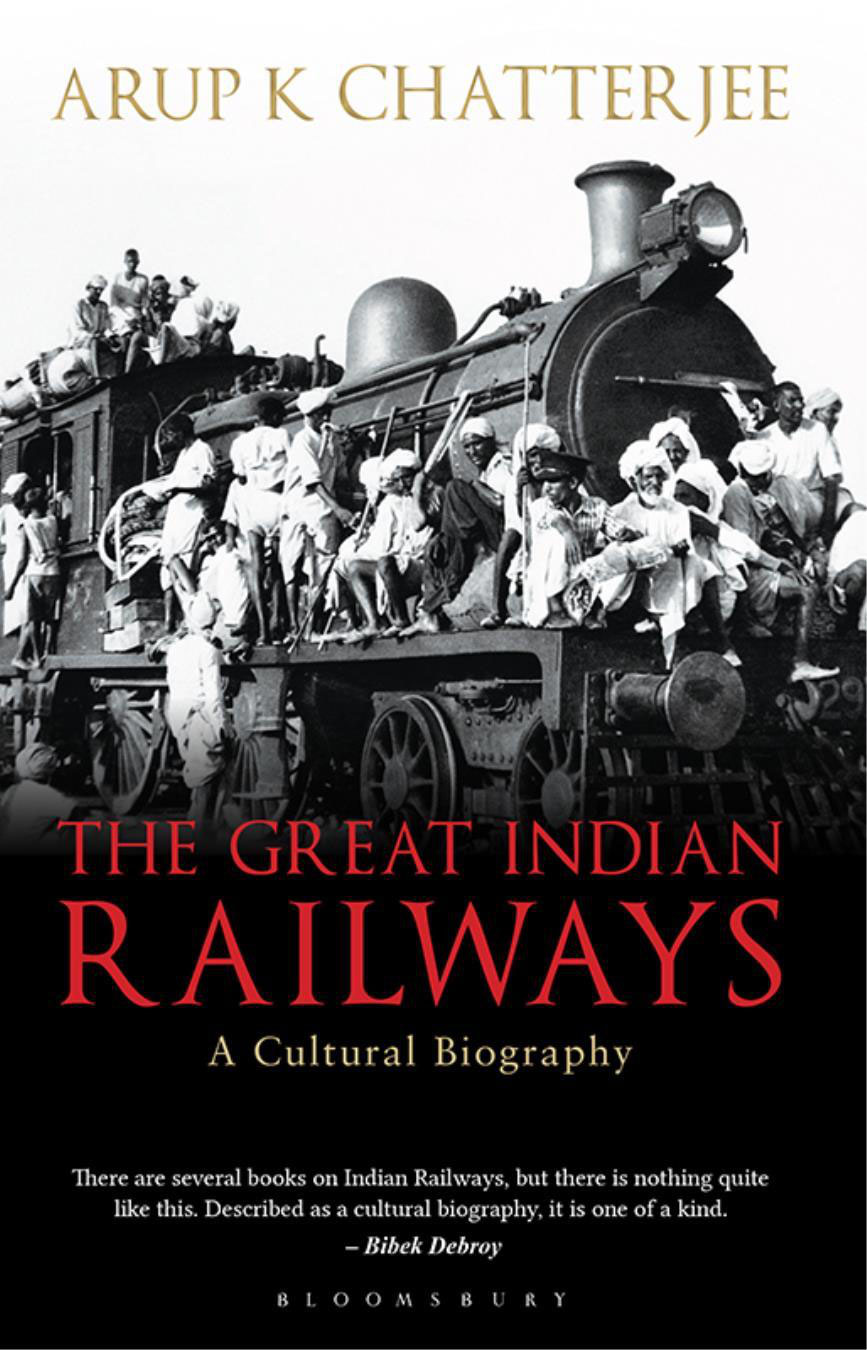THE GREAT INDIAN
RAILWAYS
A CULTURAL BIOGRAPHY
THE GREAT INDIAN
RAILWAYS
A CULTURAL BIOGRAPHY
ARUP K CHATTERJEE

This is a rare and unique perspective on the cultural history of an organization as perceived by writers, critics, films, colonial rulers and local citizenry from the 1840s till today The most powerful chapter is the one on Partition, where the Railways become the Dumb Waiters and purveyors of destiny of two nations. The horrors of Partition generated a large number of books, short stories and films, reminding us of the bestiality and violence on a scale rarely seen in history, while the national leadership looked on helplessly. Here, the author draws from Khushwant Singhs Train to Pakistan, Krishan Chanders Peshawar Express, a story where the train itself is the narrator of events that took place on it, Bhisham Sahnis Amritsar Aa Gaya, Sadat Hasan Mantos Kasri Nafisi and many moreArup K. Chatterjee vividly captures the debates about its impact and on its changing cultural influence over timeChatterjee is a professor of English; his command over language and facility with it, apart from his unique perspective on the railways, makes this exceptional book compulsive reading.
Outlook
Arup K. Chatterjee... traces the 156-year-history of the Indian Railways from an unusual anglehow the railways influenced the cultural milieu of India through not only literature, films and songs, but also catalyzed revolutionary changes in the countrys political and social canvas. It was the beginning of a new India after the first passenger train ran in Bombay on August 15, 1853. Railways are yet to reach all nooks and corners of India. The changes therefore are continuing.
The Hindu
For the author, the railways is not just an actually existing entity, but is, rather, a myth of tremendously Indian proportions, invoked and evoked in all forms of the national and popular imaginationThis book attempts not just to create a new genre, but to set down new tracks for thought, method and writing in the area of culture studiesThe perspective Chatterjee brings to this subject is a new and courageous one: rather than drafting a catalogue of novels, films, diaries and journals that have the railways as their theme, which would be expected in such a work, he investigates how the railways themselves affect the form and content of their own representationsThe greatest achievement of this book is that it gathers and collects the myths, narratives and histories of the Indian Railways from sources as disparate as colonial archives and popular movies. Chatterjee successfully conjures up the magic in a lucid style, while maintaining the gravity and solemn tone reminiscent of a train journey.
Scroll
Chatterjees courage in undertaking such a vast endeavour is laudablethe book is thoroughly enjoyable, even if it is just for its rich trivia.
The Telegraph
Chatterjee moves with ease, from literature to history to politics to cinema, in a juxtaposition of exciting styles and frames of reference, and in a language which he calls symbolic of the railways themselves: Why should not the language of a railway book pay homage to the institution, the times and eras in which its changing narratives belong? From the first proposals for the Indian Railways, to Dwarkanath Tagore and Rowland Macdonald Stephensons economic alliances over building them, the Great War of Independence to the age of Kipling, from the Civil Disobedience to the Quit India Movement, to the reconstruction of the Pamban Bridge and the burst of Eastman colour on celluloid screens in the 1960s, the Indian Railways emerge as a palpable protagonist in Chatterjees work.
Sunday Guardian
There are several books on Indian Railways (meaning mostly the history), but there is nothing quite like this. Described as a cultural biography, it is one of a kind.
Bibek Debroy, in Business Standard
Chatterjee really hits his stride as he chronicles half a century over intense cultural presence of railways from the stories and films of Satyajit Ray, to a whole yard of Bollywood films, and the novellas of Ruskin Bond. There is hard to find any cultural manifestation he has left outit is a repository of rare treasures about our lives intersections with railways down the years which will survive phasing of steam engines and meter gauge lines.
IANS
Long years before Jawaharlal Nehru spoke of the idiomatic tryst, Indias destiny had been set in motion on iron wheels, from Bombay in 1853. The day was a public holiday. At 3:30 pm, as the 21 guns roared together, the first train carrying Lady Falkland, wife of Governor of Bombay, along with 400 special invitees, steamed off Ninety-four years later, the city was one of the farthest points, from the new nation of Pakistan, from which refugees were forced to leave: leaving one independent nation behind, to live in another. From there, those who took The Purveyors of Destinythe partition-trainswent up to Amritsar. Many from India reached Jatto, Mughalpura, Lahore, Karachi, or Rawalpindi; some miraculously alive. Others became part of the rubble on railway platforms, at premature destinies.
(The Dumbwaiters of Partition and The Great Indian Railways)
BLOOMSBURY INDIA
Bloomsbury Publishing India Pvt. Ltd
Second Floor, LSC Building No. 4, DDA Complex, Pocket C 6 & 7,
Vasant Kunj, New Delhi 110070
BLOOMSBURY, BLOOMSBURY INDIA and the Diana logo are trademarks of Bloomsbury Publishing Plc
First published 2017
Reprinted 2018
Copyright Arup K Chatterjee, 2017
All rights reserved. No part of this publication may be reproduced or transmitted in any form or by any means, electronic or mechanical, including photocopying, recording, or any information storage or retrieval system, without prior permission in writing from the publishers
Bloomsbury Publishing Plc does not have any control over, or responsibility for, any third-party websites referred to or in this book. All internet addresses given in this book were correct at the time of going to press. The author and publisher regret any inconvenience caused if addresses have changed or sites have ceased to exist, but can accept no responsibility for any such changes
ISBN: TPB: 978-93-88414-23-4
2 4 6 8 10 9 7 5 3
Created by Manipal Digital Systems
Printed and bound in India by Replika Press Pvt Ltd
To find out more about our authors and books visit www.bloomsbury.com and sign up for our newsletters
I am aboard the Purushottam Express, which has just crossed Sasaramonce part of the historic kingdom of Kashi, and the birthplace of Sher Shah Suri, who was a ruler of Delhi, and the architect of the Grand Trunk Road.
Today, Sasaram is known for its quaint Urdu-Hindi-Bihari accent, rock quarrying, and perhaps a few other notorious attributes. I know of the town chiefly from my experience of living in an unnecessarily snobbish bungalow-colony in Tatanagar, where a lot of domestic labour and construction workers used to hail from Sasaramthat is until at least twelve years ago. My experiences and theirs were made possible chiefly with the Great Indian Railways chugging along, quietly in the background.
I might be beginning to be unreasonably oblique. Frankly, I do not mind if some maverick reviewer were to put this book in the list of toilet paperbacks. In the interest of a national service, I do hope lavatories in the railways keep running water, and toilet paper. The ones adjacent to my compartment have clearly run out of those supplies of basic human necessity, weeks ago.













